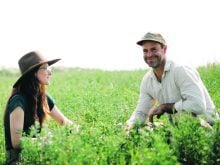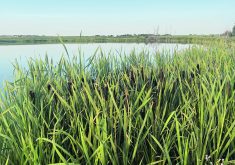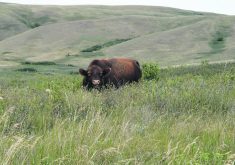Levelling technology allows farmers to grow rice in Switzerland as a way to restore unproductive swamp land
The hot August sun beats down on acres of rice plants as frogs leap along the dikes separating different paddies. A snake slithers among the reeds and hundreds of dragonflies among the green stalks are too preoccupied to pose for a picture.
It will be another few months before the grains turn golden and ready to harvest, but in these rare fields of the Swiss countryside, the different species of wetland creatures are exactly why the field is here.
It has been five years since Léandre and Maxime Guillod planted their first rice crop and became Riz du Vully, the first rice production in Switzerland north of the Alps, according to their website.
Read Also

Saskatchewan puts crown land auction on hold
Auctions of Saskatchewan crown lease land are once again on hold.
Before then, the family farm outside the village of Môtier, on the other side of Mont-Vully, was used strictly for market garden production. After Maxime brought a new leveling technique to the family farm after a year in Australia, rice also became a way they could make unproductive swamp acres productive again.
Agroscope, the National Research Institute for Agriculture in Switzerland, had been seeking ways to increase biodiversity on unproductive acres, said Léandre. With their new leveling technique and available swamp land for Agroscope’s experiment, the brothers grew the first rice ever seen in their region.
“They were looking for crops that would cope with excess water, and one of these crops was rice. But in order to grow rice, you need to have a level field. And by chance, they found our company.”
At the time, Léandre thought it would be a good way for the brothers to promote their new leveling business, but the field trial brought attention from the media and neighbours to their locally grown rice. When the first harvest brought in 800 kilograms, it sold within a matter of days, he said, and they added it to their production list.
This year, Léandre said they grew 27 acres of rice with five different varieties. With no oxygen available, weeds are not a problem, and the brothers don’t apply pesticides because the wealth of insects is part of their plan to keep the paddies teeming with biodiversity.
At the time of the interview, Léandre and Maxime had just finished harvest and expected 40-50 tonnes of rice for sale, with 80 per cent sold from their own website, said Léandre.
The remaining 20 per cent is sold through small resellers, purposefully avoiding large grocery store chains. It’s more work, said Léandre, but they feel they get more revenue this way.
According to the U.S. Department of Agriculture’s Foreign Agricultural Service, the European Union produced 1.38 million tonnes of rice in 2023, 0.3 per cent of global production.
Léandre admits that Riz du Vully’s production is just a drop in the bucket, but he is happy with what they have achieved.
Through bettering their techniques and putting as many acres as they can into production, Léandre said they have maximized their number of rice fields. Due to government regulations, they cannot exceed 60 per cent of total acres when it comes to the number of cereal crops, including rice, but have improved yields through better production methods.
Léandre said they grow all their seedlings themselves to transplant into the paddies. In the last few years, they’ve improved their transplanting success to 90 per cent. This year had the best yields yet.
The point of testing rice production in Switzerland was to increase biodiversity, and now half of the Guillods’ acres do that and receive direct payments from the government of about 1,000 Swiss francs (C$1,580) per hectare.
As for other environmental outputs, like carbon dioxide and methane, researchers are studying how rice performs compared to dryland crops. Preliminary data is promising, Léandre said.
Crop rotation plays a huge role in managing fertilizer needs and soil borne diseases. Leveling and controlling water levels make rice paddies a permanent fixture of the landscape.
“Crop rotation is mainly to control soil disease. Thanks to flooding, we can solve that problem,” said Léandre. Since rice was initially planted on acres that weren’t suitable for vegetable crops, the rice paddies will remain where they are.

















